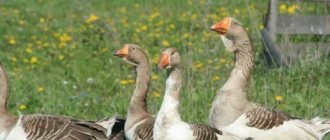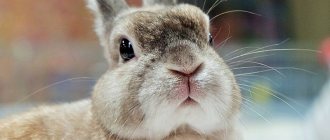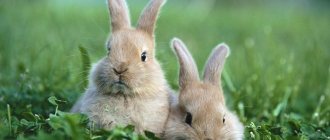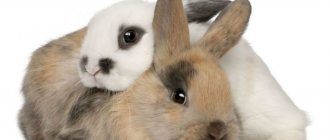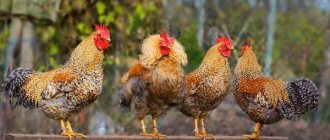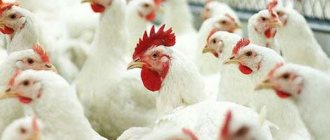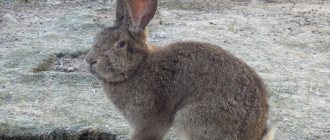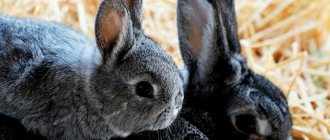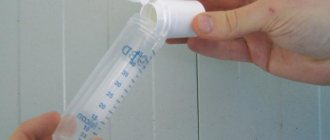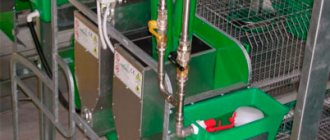Nowadays, people's needs for dietary meat have increased. After all, people are increasingly beginning to switch to a healthy lifestyle, which includes proper nutrition. It is also difficult to imagine a children's menu without easily digestible meat products. To meet the demand of the population, farms began to raise meat breeds of rabbits, which are easy to breed and have a high yield of dietary rabbit meat.
Rabbits for meat grow quickly - at 4-5 months they can already be sent to slaughter. Among all the positive aspects, it is worth noting the calm nature of the animals, good immunity and frequent reproduction.
Classic meat rabbit breeds
Among the meat breeds, the following species are in demand among rabbit breeders:
| Breed name | Photo | Weight of an adult animal | Meat yield |
| Flanders | 7-8 kg (sometimes there are individuals with a body weight of 10-12 kg) | Approximately 55% | |
| Gray giant | 4.1-7 kg | Up to 60% | |
| Soviet chinchilla | About 5kg | 60-64% | |
| White giant | 5-6 kg | 56-59% | |
| Risen | 10-15 kg | Up to 65% | |
| New Zealand White | 4-5 kg | 54-58% | |
| Californian | 3-4 kg | 56-60% | |
| White pannon | 4.5-5 kg | Up to 62% | |
| Poltava silver | 5-6 kg | 60-65% | |
| Vienna Blue | 4.5-7 kg | 56-59% | |
| Rex | 3-4 kg | 58-60% | |
| Butterfly | 4-5 kg | 52-58% |
What are the benefits of meat rabbit products?
The nutritional value of rabbit meat is significantly higher than that of other animals. One adult carcass contains up to 85% muscle tissue. The meat of young rabbits is considered to be the most delicious. Choosing one is quite simple: its carcass should not exceed 1 kg in weight. Externally, rabbit meat looks white with a pinkish tint. It is quite dense, yet non-greasy. The bones are thin.
The largest varieties of rabbits
Large varieties of rabbits are usually not of the meat variety, but of the meat and skin variety. When compared with exclusively meat breeds, representatives of the meat and skin breed do not grow as quickly, which is why more nutrition is spent on them. Giant eared animals are characterized by low fertility and late puberty. But such nuances are easily compensated for by obtaining larger skins.
Large breeds include the following species: Flanders or Belgian giant, Gray giant, Soviet chinchilla, White giant, Risen. Each purebred representative from this group can boast a fur coat of impeccable quality, original color, and a high yield of quality meat.
Tips for buying meat rabbit
Study the rabbit's physical characteristics and carefully examine the animal for signs of ill health and underdevelopment.
- Make sure both of the animal's eyes are bright and clear, which is a typical sign of good health.
- There should be no signs of shedding on the rabbit's fur. If fur shedding is present, the coat will not feel soft or clean to the touch due to unsanitary living conditions or disease.
- The rabbit's teeth should show no signs of overgrowth and should be properly aligned. A rabbit showing signs of overgrowth likely either has a jaw alignment problem that is preventing it from naturally grinding down its teeth, or an internal disease.
- There should be no discharge on the rabbit's nose. A rabbit with constant sniffling may have Pasteurella, which is often a fatal and contagious disease.
- If possible, ask to see the breeding couple that produced the rabbits. You should expect a healthy rabbit to sniffle or even sneeze occasionally, but there should not be snot coming out of its nose all the time.
If you handle a rabbit with these obvious problems, be sure to thoroughly sanitize your hands before handling another rabbit.
Features of large species
It may seem that the best breeds for breeding are large breeds, from which you can get a lot of rabbit meat. Giants amaze with their impressive size, but such giants have many disadvantages. When keeping long-eared animals, increased volumes of feed will be required according to the needs of the animals, large spacious cages, and a lot of bedding. In addition, large rabbits are susceptible to obesity and limb deformities.
Although large-bred eared animals have many negative aspects, their cultivation is common among farmers. They are popular for their peaceful disposition, resistance to viral diseases that are found among rabbits, as well as tasty meat and luxurious large skins.
Description of individual breeds of meat rabbits
Meat rabbits are selected based on the preferences of the rabbit breeder and the goals set for breeding the creatures. Most often, the selection criteria are the size of the animal and fertility. Let's look at the most common meat types.
- The California rabbit is the most prolific breed (8–12 rabbits per litter) with an average weight of 4–6 kg. Pure meat – up to 75%. The animal is not prone to obesity, adapts quickly, does not require special care, and has high immunity. The fur coat is snow-white with black ears, “socks”, and a spot on the face. High quality fur, suitable for dressing.
- The New Zealand white rabbit is a prolific variety (8–11 babies per litter), gaining weight up to 6 kg. High percentage of slaughter yield – up to 78%. The most expensive rabbit on the market. Easy to care for, non-aggressive, hardy. The color of the animals is monochromatic, resulting from the name of the species.
- The gray giant is bred for its high fertility (up to 11 rabbits per litter) and weight reaching 7 kg. The slaughter yield is high, the character is calm and flexible. The fur coat is gray with dark tints.
- The white giant is considered less fertile than the gray one - up to 9 rabbits in a litter. A rodent with snow-white fur reaches up to 8 kg in weight with a yield of pure meat of up to 74%. Requires more effort when caring than other animals. Afraid of drafts, requires a lot of space. But pets’ immunity is strong.
- Another large species is the Soviet chinchilla. The pet gains weight up to 8 kg, with a slaughter yield of up to 75%. The coat color is chinchilla, with various shades of gray. They reproduce up to 8 young. Resistant to cold, characterized by strong immunity.
- The largest meat rabbits belong to the Flandres (Belgian giant) species. The weight of an adult reaches 12 kg with proper care. Flandre's record weight is 25 kg. The litter contains up to 8 rabbits. The coat color is varied from shades of white and black to beige and red. A distinctive feature of the pet is its wide, long, protruding ears. Rabbits are voracious and demanding of food and food. The meat yield is only 70%. The pet skin is not tanned due to its low quality.
- Viennese blue rabbits also belong to the meat category. Weight is 5 kg. The offspring contains 8–9 animals. It is resistant to changes in weather conditions and cold. It is also used for tanning hides.
When choosing an animal, you should take into account the origin of the variety. Varieties bred in Russia or Ukraine are adapted to more severe conditions than their southern counterparts.
How to keep and breed meat rabbits
When breeding meat rabbit breeds, certain recommendations are followed:
- Female rabbits selected for production must be housed in separate cages.
- Mating is recommended to begin at 6 months of age.
To increase fertility, females can add apple cider vinegar to their drink!
- Animals are recommended to be kept in cages or enclosures.
- The dimensions of rabbit houses must correspond to the size of the rabbits.
- Maintaining cleanliness in rabbit hutches, regular disinfection of premises, equipment, deratization, disinfestation.
- In winter, long-eared animals should be placed in warm, heated rooms and protected from drafts.
- Eared animals are vaccinated against common diseases according to the vaccination calendar.
To protect eared animals from coccidiosis, iodine solution is used in drinking water. After jigging, young animals are given a 0.01% iodine solution for 10 days, 50 ml, then a break for 5 days, and switch to a 0.02% iodine solution - 70 ml for each rabbit for 5-7 days, the next 8-10 days – 100 ml each.
From the 25th day of pregnancy to the 5th day after giving birth, pregnant female rabbits are given a 0.01% iodine solution, 100 ml. After a 5-day break, a 0.02% iodine solution is added to drinking water for 10 days, 200 ml per day.
- A balanced diet enriched with proteins is recommended for animals.
- When raising rabbits for meat at home, two methods are used: purebred mating (there are individuals of only one breed, which leads to improved offspring according to the main species characteristics) and crossing of different breeds (there are representatives from different breeds, in order to renew the blood and obtain species with improved characteristics).
Rabbits for meat can be raised even in an apartment, providing them with the necessary conditions, protecting them from other pets and children. “Meat” rabbits mature quickly and gain muscle mass well. By 5-6 months you can get a lot of dietary meat from them.
Video Breeds of rabbits for meat: is it better to breed purebreds or crossbreeds?
How to choose a breed for breeding at home
For breeding at home, it is better to choose those species that tolerate local climatic conditions well and are easy to care for. For example, in warm climatic zones you can grow all varieties of eared ones, and for regions with a harsh climate, unpretentious hybrids are better suited: Riesen, Soviet chinchilla, Poltava silver.
When choosing, you need to focus on your physical and material capabilities, because young eared representatives of the meat sector have a high cost and require corresponding financial costs and labor resources when growing.
How to feed meat rabbits
Tender dietary rabbit meat can be obtained from long-eared rabbits that have been properly fed.
Feeding rabbits for meat should be varied. The diet should contain the following components:
- Lots of food containing proteins (cereals, legumes, green food, fish, bone meal);
- Carbohydrates (cereals, succulent foods, legumes);
- Vitamins, minerals;
- Compound feed.
How to raise quality rabbits for meat
The key to raising quality meat rabbits, especially for beginners, is to start small. Invest in proven breeding animals and buy only one stag and one doe. Rabbits, as we all know, reproduce quickly.
A new rabbit breeder simply will not be able to adequately perform the daily health checks, feeding and cage cleaning required for multiple breeding pairs or groups from day one - at least not when raising healthy animals that produce satisfactory meat.
Once you've truly learned the ropes of raising meat rabbits, it's time to expand your colony and start cutting up and preserving meat. The ideal ratio for a colony of meat rabbits is one male to three females. Such a family should most likely produce up to 50 rabbits per year.
It may seem shocking, but if you buy a few female rabbits and one or two males, it won't take long to create a rabbit colony of 100 rabbits.
Here's a quick breakdown of the amount of work per week it takes to care for such a large colony while waiting for them to reach meat weight:
- Feeding - 2 ½ hours.
- Cleaning the cage - 5 ½ hours.
- Mating - 2 ½ hours.
- Weaning kits and nest care - 3 hours
- Cleaning the feeder and water container - 4 ½ hours
- Health checks - 2 hours.
Despite the time involved, raising rabbits for meat is worth the effort.
Homemade
Representatives of domestic breeds of rabbits can be kept both outdoors (for meat and fur) and at home - in a special cage. Animals can freeze outside in cool weather.
The home cage is lined with sawdust or straw, which is changed regularly.
Animals are not allowed to walk around the apartment! It happily chews furniture upholstery, wires and other interior items. Rabbits of these breeds can be trained to defecate in a tray with a special filler.
Butterfly
This English breed was originally considered a decorative breed. Later representatives of the breed were crossed with Flanders and Viennese Blues. Hybrids are grown for their skins.
Adults have a compact body with a small head and short erect ears. Body length 56-58 centimeters. The chest and back are wide. The limbs are long.
The skeleton is strong with well-developed muscles. The fur is short and thick. The main color of the skin is white. A characteristic feature is the presence of black-brown spots. The nose, ears and scruff are black.
There is a dark stripe in the center of the back. Weight up to 4.5 kilograms or more. The female is fertile, bringing up to 8 babies in one litter.
Vienna blue
The result of crossing the Flanders and Moravian Blue breeds. This hybrid can be classified as an endangered species.
The body is folded proportionally. The head is neat with straight ears rounded at the ends. The back is wide. The body is medium in size with a rounded croup.
Limbs are straight and strong. The fur is thick, uniformly colored bluish-blue. The inner surface of the ears is light. Average weight 4.5 kilograms. The female gives birth to up to 9 babies in one litter. The breed is valued for its high fluff content - the skin is extremely delicate and soft.
Squirrel
In 1916, German specialists bred rabbits with extremely decorative, high-quality fur. It is thanks to its originality and quality that the breed acquired its name - Belka, due to its similarity with Aleutian squirrels. These animals were bred through repeated crossings of Havanna and Blue Vienna breeds.
Rabbits of this breed are bred mainly for their fur, although the breed is considered a meat-skin breed, the skins are of high quality, unusually colored and are widely in demand in the fur industry. The breed is poorly represented in our country and is mainly bred in Germany.
Among the advantages of this breed, the main ones are low demands on feed and fairly simple conditions of keeping and rearing. Rabbits of this breed adapt well to various weather conditions, they can even be kept outdoors, they are quite hardy and resistant to diseases of the species.
Tortoiseshells
The history of selection of tortoiseshell rabbits is unknown; they are very rare and, unfortunately, only among those who like to breed rare breeds of rabbits. The rabbit breeders who developed this breed were obviously aimed at obtaining beautiful skins, and only then for meat.
The tortoiseshell rabbit is of medium size, quite strong in constitution, and its body composition is expressed in correct proportions. It got its name because of the peculiar original color of its fur.
The color is yellow-reddish, but with a slightly pronounced reddish tint, reminiscent of the skin of a fox at the height of summer. An adult tortoiseshell rabbit gains weight up to 4.5 kilograms.
Mothers from tortoiseshell rabbits turn out wonderful, they are quite balanced and give a large amount of milk, the rabbits grow quickly and you don’t have to worry about their safety.
Keeping a tortoiseshell rabbit is not particularly difficult, since they are unpretentious and can easily tolerate even harsh climatic conditions when kept in outdoor cages.
High quality fur products are made from the skins of tortoiseshell rabbits and have an excellent natural appearance. All this has greatly raised the price bar for the fur of these animals.
Ram
The Ram breed currently has several types of rabbits. The main breed was developed in England.
The main difference is the long ears that hang down freely. The length of such unusual ears is from 18 to 72 centimeters. The size of adult individuals can be either miniature or large.
The body is compact, the limbs are short. The color depends on the specific species. There are black, blue, spotted, red and other colors. The length and thickness of the fur also varies depending on the species.
Large representatives weigh from 4 to 8 kilograms. They are raised for their skins and meat. The weight of dwarf species averages from 1.5 to 3 kilograms. Such animals are kept in apartments as pets.
Ermine breed
Originally from England. It was brought to our country at the beginning of the last century.
The body of adults is short (up to 52 centimeters). The head is round with erect ears. Chest circumference 29-34 centimeters. The back is arched, the croup is rounded.
Limbs are straight. The fur is thick. The main body color is white. The tip of the nose, paws, ears and tail are black or brown. Average weight is from 3 to 4 kilograms.
The female brings up to 8 babies per litter. The breed is unpretentious to living conditions. Valued for its beautiful fur. To improve the appearance of the animals, they are bathed with the addition of a special shampoo.
Soviet Marder
Created by crossing two breeds: Ermine and Chinchilla.
Body length in adults is up to 50 centimeters. The chest is wide, measuring 31 centimeters. The limbs are dense and relatively short. The head is small with erect ears.
The fur is short and thick. Body color is brownish. The paws, muzzle, back and tail are always of a darker shade. Average weight is from 3 to 4.2 kilograms. The female gives birth to 7 babies per litter. The fur of adult animals has a high fluff content.
Rex
Appeared as a result of a natural mutation of Flandres. The body of adults is compact with a rounded croup. The head is small.
A characteristic difference is an underdeveloped mustache. They are much shorter than any other breed. The ears are fleshy and erect. Limbs of medium length. Weight from 3 to 5 kilograms. The fur is thick and dense, but very short (plush).
Curly hairs are found only on the nape and belly. The color is chestnut or brown with lighter spots. The breed is valued for its beautiful skin. The animals are distinguished by their playfulness and affectionate disposition. They are often kept in apartments as pets.
Red New Zealand
In addition to the white New Zealand rabbits, there is a red variety that is also used for fur and meat.
The weight of strong, well-fed animals up to half a meter in length does not exceed 4.5 kg, but the relatively low carcass weight is compensated by the high taste, fertility and endurance of the breed.
The peculiarity of this meat breed of rabbits is its bright unusual color, which can vary from brick-red to deep red. Beautiful fur, hairy paws, compact build - all this makes it possible to raise New Zealand red rabbits outdoors even in rather harsh conditions.
What to feed meat rabbits
In industrial production, meat rabbits are fed hay and complete specialized pellets, providing the animals with free access to food and water. In fact, this is an ideal diet for rabbits, which allows you to avoid such a common phenomenon as bloating.
In household farms, the diet of pedigree rabbits includes vegetables:
- cabbage;
- beets;
- carrot;
- potato.
In summer, the main food products for rabbits are greens and vegetables, in winter - hay, grain and high-quality compound feed. Wild herbs useful for rabbits:
- dandelion;
- nettle;
- plantain;
- alfalfa.
Important! To maintain the health of rabbits, they need a complex of vitamins, which can be purchased at a veterinary store.
Main types of rocks
There are 4 types of rabbit breeds: meat, meat-skin, decorative and wild. The first two varieties are suitable for cultivation in subsidiary plots.
Meat-skin breeds are bred not only to produce meat, but also high-quality skins. Such breeds weigh more than meat breeds, but they grow more slowly, their puberty occurs later, and they are not distinguished by high fertility.
Meat rabbits
Meat rabbits are profitable from a profit point of view in that they grow quickly and are ready for slaughter at the age of 4-5 months. In addition, meat breeds are distinguished by a calm character, strong immunity and high-quality reproduction.
Decorative
Breeds of decorative rabbits are dwarf animals, similar to domestic ones. Their distinctive feature is large eyes and short ears.
Among the decorative ones there are: lion-headed breed, dwarf rex, dwarf ram, dwarf fox and hermelin.
Lionhead
A cross between short-haired and fluffy animals gave rise to the Lionhead breed. The animals got their name due to the resemblance of the head to a lion's mane.
A thick mop of long hair covers the head and torso. The rest of the body is covered with short hair of various shades. The animals are small, their weight does not exceed 1.7 kg. They are easy to keep and care for.
Dwarf rex
Short-haired individuals whose skin color is similar to that of a beaver belong to the Dwarf Rex breed. The features of dwarfism appear much more clearly due to the short hairline.
They have underdeveloped, crooked whiskers, which is a sign of the purebred breed. The eyes are large, close to each other. Body length 50 cm, total weight – 1.4 kg. The color is different.
Dwarf ram
Animals of the dwarf ram breed can be called giants among dwarfs, which does not prevent them from having a calm and docile character. The body is massive, 24-27 cm long and weighing 1.5 kg.
The eyes are beautiful and big. The paws are of medium thickness, the small tail is pressed to the body. The skin is soft and silky. The color is varied. The peculiarity of this species is its hanging ears, similar to those of a lamb.
Pygmy fox
But the dwarf fox is rightfully considered the midget among dwarfs, because the mass of animals of this breed is only 1.3 kg. The animals have a changeable character, and their body seems to be covered with a hanging woolen cloak.
The coat color can be either light tones (white, silver) or more saturated (Havana, black, blue, yellow).
Hermelin
Cute decorative white pets with blue eyes represent the Hermelin breed. Their weight is within 1.5 kg, and in their appearance they resemble Persian cats.
Hermelines are stocky, tightly knit, with small, rounded, closely spaced ears, and the neck is invisible.
The front legs are short, the claws are colorless. The coat is thick and shiny. The animal does not require special attention during maintenance and care.
Dutch mini rabbit
The classic color of pets is considered white and black with colored circles around the eyes, on the ears and hind legs in the form of socks. There are about 20 shades of fur coat from light gray to tortoiseshell.
The average weight of an adult Dutch dwarf is about 1.5 kg. In this regard, a care cage is purchased with a size of 50*70 cm. It should be equipped with a place for sleeping and feeding. Food can be purchased in specialized stores, adding vegetables, fruits, hay or grass to it in the summer.
Flexible colored dwarf
A small rabbit looks like a dense ball with small ears, which weighs from 1 to 1.3 kg. His fur is thick, shiny, dense to the touch. There is no specific color, because the breed has about 50 shades. The most famous of them are Siamese, chocolate, Russian, blue, white guard and squirrel.
Colored dwarfs quickly adapt to their new home. They have a calm character, are not shy, allow themselves to be picked up and even stand on their hind legs to greet their owner. The manifestation of aggression indicates that the animal is in sexual heat.
Features of crossing
To obtain a new highly productive breed of rabbits, the best specimens are selected for crossing. Most often, breeding representatives of their species participate in selection.
To improve the productivity of meat breeds, Flanders are usually used, since these animals are the heaviest of all.
Crossing can be divided into two types: introductory and industrial. If the first is intended to eliminate any shortcomings in animals (for example, low weight, low fertility, low slaughter yield), then industrial crossing is aimed at improving the quality of existing positive traits.
You might also be interested in the White Giant breed.
New Zealand white and red rabbits
The name of this rabbit has nothing to do with the country in which they were bred. They were received in the USA in 1910. New Zealand Red differs only in its color and is slightly inferior in weight to white. From albinos of this breed, a white New Zealander was bred, which has the best indicators for meat and growth. An adult white New Zealand rabbit reaches a weight of 4.5 kg.
The body structure of the New Zealand rabbit does not have any characteristic features. The body is of medium length in the shape of a cylinder, a relatively small head with straight, erect small ears. The rounded croup has a wide chest, the paws are straight and quite strong.
The fur has a uniform white color, its consistency is thick and dense, the hair is short with a slight shine. The muzzle, paws, tail and ends of the ears sometimes have a dark edging in this breed, which is considered normal and does not pass as a defect. The standard body length for a female rabbit is 49.5 cm, and for a male it is 2 cm less.
A calm disposition and slight sensitivity to sounds allows the New Zealand rabbit not to be scared and avoid unnecessary stress. Good milk production and fertility of females is visible in the offspring, which can be up to 12 rabbits. Females are very caring and the rabbits grow quickly, at the age of 3 months their weight reaches 2.7 kg.
Diseases and treatment of meat rabbits
Diseases characteristic of rabbits can be divided into 2 types: infectious and non-infectious. Among the infectious ones there are:
- Cysticercosis is a liver disease caused by cestode larvae.
- Coccidosis is an infection of the gastrointestinal tract of an animal, resulting in death in 70% of cases.
- Pasteurellosis is a dangerous disease that destroys livestock in a few days. It often comes to animals from birds and rodents; it can be cured with antibiotics if the farmer notices the first sign of the disease in time: the sick rabbit’s high body temperature of 42°C.
- Myxomatosis is characterized by the appearance on the body of a rabbit of myxots - small nodules that scatter the body. There is no method of treatment - the animal is euthanized, the clothes of the person in contact are burned, and the feces of the sick animal are buried to a depth of a meter. The disease should be reported to the veterinary service.
- Listerosis - transmitted from ticks, fleas and lice, dangerous for humans. This disease is treated with antibiotics, which is ineffective: it is better to euthanize the sick animal.
The best prevention of infectious diseases is timely vaccination of livestock.
Among non-communicable diseases, pneumonia and poisoning should be highlighted.
The first occurs in the presence of drafts, high humidity and sudden changes in pressure. Characterized by lack of appetite, increased body temperature, wheezing breathing and nasal discharge. For treatment, the animal is placed in comfortable conditions, given balanced food and plenty of fluids, and treated with antibiotics.
Antibiotics
Poisoning occurs due to poor quality nutrition, as well as poisonous plants entering the feeder. The disease is characterized by vomiting, diarrhea, and loss of strength. First of all, the rabbit is offered plenty of fluids and the right nutrition is selected. You can give a sick individual a drink of rice or oatmeal broth, which will help stop diarrhea and remove toxins from the body.
In animal breeding, the main criterion is profitability. Therefore, preference should be given to the type of animal that will provide high benefits, such as rabbits. The best breeds bred by breeders will allow everyone to find rabbits to their liking and get maximum profit from the sale of rabbit meat from the farm.
0 0 votes
Article rating
